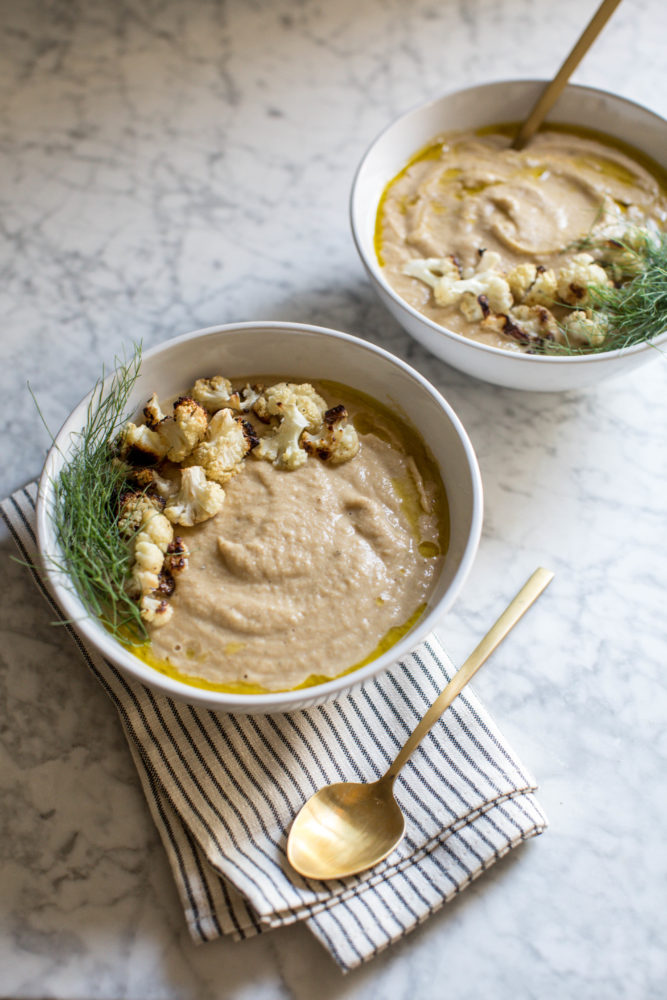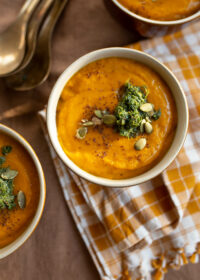Recipes: Roasted Cauliflower & Fennel Soup
 In summer, we move quickly. We say yes to more, pull a few more late nights than normal and push ourselves harder through our full schedules. Okay, we probably do that all year round, given the nature of our society’s pace. However, come Fall, we might notice feeling more anxious than we do in Spring and struggle to sleep well, think clearly, keep a consistent routine, and feel grounded in our day-to-day.
In summer, we move quickly. We say yes to more, pull a few more late nights than normal and push ourselves harder through our full schedules. Okay, we probably do that all year round, given the nature of our society’s pace. However, come Fall, we might notice feeling more anxious than we do in Spring and struggle to sleep well, think clearly, keep a consistent routine, and feel grounded in our day-to-day.
In Ayurvedic teachings, Fall is actually the most vulnerable time of year for our health. With the excess movement of summer and the swift change to new weather around us, the elements of air + space (known as vata dosha) increase. The qualities of Vata are dry, light, cold and mobile. You can observe this around you in nature as the wind blows the drying leaves on the trees. Within our bodies, Vata dosha governs the nervous system, the mind, and the cavities – like the joints, colon and air passage ways. With the awareness that like increases like, too much movement, eating on the go, staying up late and skipping our personal routines, exacerbates the qualities of air and space in our lives. With both this internal and external increase, this can bring a racing mind, fearful emotions, scattered thinking, excessive talking and that general feeling of anxiety.
So what is needed? A simple shift in your daily flow. Create stability in your personal morning and evening routines. As a business owner with a Vata dominant constitution, I have to be extra mindful this time of year to not over-schedule clients, travel and outward commitments. I focus on taking time to myself in the morning, eating at warming, cooked foods at consistent meal times, and applying oil to my body and especially feet before I climb into bed. With awareness, I’ve been able to overcome my seasonal emotional dips by bringing in the opposite qualities that support the erratic nature of Vata – warming, slow, steady, stable, oily and cooked. And even if the outer environment here is still experiencing a final heat wave, my inner environment is feeling the shift.
 So if you have too, take a moment to reflect on your daily routines and how you can address that autumn anxiety with some simple shifts of self-reflection and empowered action. These are the kinds of topics I’ll be discussing in more detail in my Fall Renewal Guided Cleanse program, which kicks off this Sunday! If you’d like to explore what it means to create a personal wellness practice rooted in the science of nature, join the program alongside a community of incredible teachers and like-minded friends. We’d love to welcome you in!
So if you have too, take a moment to reflect on your daily routines and how you can address that autumn anxiety with some simple shifts of self-reflection and empowered action. These are the kinds of topics I’ll be discussing in more detail in my Fall Renewal Guided Cleanse program, which kicks off this Sunday! If you’d like to explore what it means to create a personal wellness practice rooted in the science of nature, join the program alongside a community of incredible teachers and like-minded friends. We’d love to welcome you in!
 With fall officially here, I’ve been turning to friends for new recipe inspiration. My girl Jessica Murnane of One Part Plant + Podcast came out with an incredible new cookbook, One Part Plant. It’s a beautifully designed book that makes eating one plant-based meal a day easy and approachable. Her recipes are delicious and paired with time-maximizing tips and personal anecdotes. I have a special place in my kitchen for the books I use regularly, and this one has found a cozy home on that shelf with pages creased and a few blender spatters on the cover now. I’m sharing a recipe from her book for this Roasted Cauliflower & Fennel Soup below, which I’ve made more than a few times now. Try the soup, and definitely buy her book to round of your kitchen repertoire!
With fall officially here, I’ve been turning to friends for new recipe inspiration. My girl Jessica Murnane of One Part Plant + Podcast came out with an incredible new cookbook, One Part Plant. It’s a beautifully designed book that makes eating one plant-based meal a day easy and approachable. Her recipes are delicious and paired with time-maximizing tips and personal anecdotes. I have a special place in my kitchen for the books I use regularly, and this one has found a cozy home on that shelf with pages creased and a few blender spatters on the cover now. I’m sharing a recipe from her book for this Roasted Cauliflower & Fennel Soup below, which I’ve made more than a few times now. Try the soup, and definitely buy her book to round of your kitchen repertoire!
 ROASTED CAULIFLOWER & FENNEL SOUP
ROASTED CAULIFLOWER & FENNEL SOUP
1 medium cauliflower, cut into florets
Olive Oil
Sea salt & pepper
1 fennel bulb, sliced – fronds trimmed & discarded
1/2 cup raw cashews, soaked for at least a couple hours (overnight is best), drained
3 cups veggie broth, plus more if needed
Olive oil, coconut or grape seed oil, if desired for sautéing
1 medium onion, diced
2 garlic cloves, diced *Or a pinch of Asafetida (hing) instead of garlic
Preheat the oven to 425 degrees. Line a large baking sheet with parchment paper. Toss the cauliflower with a little olive oil, salt and pepper. Do the same with the fennel. Spread cauliflower on one end of the baking sheet and the fennel on the other. Roast them for 10 minutes, then turn the veggies with a spatula. After 20 minutes, check to see if the fennel is soft and has browned a little on the edge. It should be ready, but might need more time. When it’s ready, remove the pan from the oven, transfer the fennel to a bowl or plate, and set aside.
With a spatula, spread the cauliflower out over the whole plan and roast it for another 5-10 minutes, until it is also soft and browned on the edges. When it’s finished cooking, set a few floats aside to use f or garnish.
While the cauliflower is roasting, add the cashews and 1 cup of veggie broth to a high-speed blender and blend until the mixture is completely smooth. This might take up to 5 minutes, depending on the speed of your blender. Leave the cashew mixture in the blender. You’ll be adding the rest of the ingredients soon.
Heat a little glug of olive oil (or oil of choice) and a couple of tablespoons of the veggie broth in a pan and place it over medium heat. When the pan is hot, add the onion and sauté until the pieces are soft and translucent, 5 to 7 minutes. Add the garlic and sauté for a few more minutes. Add the remaining 2 cups veggie broth and heat for a couple of minutes.
Working in batches, if necessary, transfer the contents of the pan, the cauliflower and the fennel, to the blender with the blended cashews. Blend until the mixture is smooth, or to your desired consistency. Add more veggie broth if needed and add salt and pepper to taste. Serve with reserved cauliflower florets on top.
Makes 4-6 servings
*This recipe is an excerpt from the One Part Plant Cookbook.
 [wpmenucart]
[wpmenucart] Recipe: Whole Roasted Acorn Squash
Recipe: Whole Roasted Acorn Squash  Recipe: Persimmon Upside Down Cake
Recipe: Persimmon Upside Down Cake  Recipe: Carrot Coriander Soup
Recipe: Carrot Coriander Soup 
This is SO GOOD! I just made it and devoured a bowl for lunch. Perfect for freezing cold winter days. Thank you for sharing this!
This has been my cold weather staple, too! Do check out Jess’ book if you want more amazing recipes like this. It’s a fav in my kitchen!
I will try this recipe! Is is exciting!
This soup is amazing! Wonderfully comforting and the fennel creates an interesting flavor profile.
This is amazingly good and satisfying! Maybe it “makes 4-6 servings” elsewhere but I just ate 1/3 of it all on my own! Thank you, Claire!
Yummy- I subbed in ground almonds (left over from holiday baking) and that worked great! And this let me use the immersion blender to combine. First time for me with fennel and it was very nice.
Love the almond pulp swap! I’m always looking for ways to repurpose my almond milk pulp, I’ll have to give this a try here.
This soup was amazing! My daughter made it at Thanksgiving. The scent of the roasting fennel and cauliflower was tantalizing, but the finished soup was even better.
Since some of the family were lactose-intolerant, my daughter used a vegan “half ‘n half” made with a blend of rich nut “milks”.. This soup was served in small cups to start the meal, but people asked for more soup even though there were many other dishes offered during the feast.
Thanks for sharing!
I just made this and I loved it! I also added some quinoa and crispy kale to top and it was delicious ?
This soup is fabulous!! I just made it and had to stop myself from eating the entire batch! ? I will definitely be making this in the future. Thanks for sharing!